|
|
| |
 |
|
| |
 Zéphirin
Paquet (1818-1905) was born in Pointe-aux-Trembles (Neuville) and founded
La Compagnie Paquet Limitée. Zéphirin
Paquet (1818-1905) was born in Pointe-aux-Trembles (Neuville) and founded
La Compagnie Paquet Limitée.
|
|
| |
|
|
|
La Compagnie Paquet Limitée, a French Canadian
firm,
distinguished itself in the retail and fur-processing sectors. It became
well
known because it had branches throughout the country and published
catalogues
that promoted its mail-order service.
The Birth of the Company | The
Mail-order
Service | The Catalogues - The Retail
Division |
The Catalogues - The Wholesale Division
| Ads for the Mail-order Service | The
Mail-order and Delivery Service | Conclusion — La
Compagnie
Paquet 100 Years Later | Acknowledgements | Further
Reading
|
In the 20th century, La Compagnie Paquet Limitée was one of the
most
important French Canadian businesses in Quebec. Its founder,
Zéphirin
Paquet, was born into a family of modest means in Pointe-aux-Trembles
(Neuville),
in the Portneuf region of Quebec. He showed that he had good business
sense when
he established a company that would become a family institution and last
over
130 years.
The development of La Compagnie Paquet clearly illustrates the
firm's
capacity to adapt to change and keep up with the times. Established in
Québec,
Paquet expanded well beyond the region of the old capital in the late 19th
century.
The mail-order service contributed to that expansion, since it allowed the
company
to reach people outside the province through its catalogues, which were
published
in both French and English.
|
The Birth of the Company
The first Paquet store was founded in 1850 and was located on
Saint-Vallier
Street in the lower town in Québec. A few years earlier,
Marie-Louise
Hamel, Zéphirin's wife, had opened a small boutique on the
ground
floor of the family's home. She sold wide-brimmed hats, which she
made
herself, as well as clothing, woollens, and notions. When Zéphirin
saw
the boutique's profits, he followed his wife's advice and gave
up
his dairy farm, which he had had for several years, to look after the
small business
full time. After several moves, improvements, and property acquisitions,
the
store found a permanent site on Saint-Joseph Street, in lower town.
| |
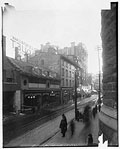 |
|
The Paquet building on
Saint-Joseph
Street, Québec. Following the great fire of 1866 in Saint-Sauveur,
the
store was moved to Saint-Joseph Street in lower town. Twelve years later,
Paquet moved to its eventual permanent location on Saint-Joseph Street,
across from Saint-Roch Church.
|
 |
|
In 1892, Paquet had two main divisions, retail and wholesale, the
latter consisting
of a fur-processing plant. The establishment of the wholesale division
represented
a major expansion, but it was the mail-order service and the catalogues
(each
division published its own) that made the store's name and
reputation known
outside Quebec.
|
The Mail-order Service
It is difficult to provide an accurate description of the early days of
Paquet's
mail-order service, which was known as CPM, because there are few primary
sources
on the subject. It is also impossible to establish with certainty when the
first
and last catalogues of the two divisions were published. However, internal
company
documents, "État comparatif des ventes, profits et
dépenses"
(comparison of sales, profits, and expenses), for the years 1897 to 1913
contain
statistics on mail-order sales, and possibly profits, for the period 1902
to
1913. The amounts vary from about $3000 in 1902 to almost $20 000 in 1904.
In
the three years that followed, sales remained around $10 000. Then,
starting
in 1911, they plunged; the modest amount of $2255 was recorded in 1913. It
may
be argued that 1902 was the first year of operation of the company's
mail-order
service and it should coincide with the publication of the first
catalogue. A
copy of the catalogue of the wholesale division, published under the
company's
former name, seems to confirm this.
| |
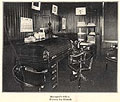 |
|
Office of the manager of J.
Arthur Paquet. The date on the calendar and the company's name, which
appears on the cover, suggest that the catalogue in which this photograph
appears was published in 1902. It may have been a commemorative edition
marking the 10th anniversary of the wholesale division, the company's
second, and perhaps the first catalogue of the mail-order service.
|
 |
|
|
The Catalogues - The Retail Division
| |
 |
|
| |
 Cover
of the catalogue of La Compagnie Paquet Limitée, Fall/Winter
1908-09,
no. 16 of the retail division. Cover
of the catalogue of La Compagnie Paquet Limitée, Fall/Winter
1908-09,
no. 16 of the retail division.
|
|
| |
|
|
|
Two documents, "Advertising Account" and "Advertising
Appropriation,"
provide information on the catalogues of the retail division, including
the frequency
of publication. It is possible to determine that there were five issues,
more
or less seasonal, in 1910 and twelve monthly issues in 1911. It seems that
no
catalogues were published in 1912 and it is impossible to determine what
happened
in the years and decades that followed.
The 1908-09 fall-and-winter edition of Paquet's catalogue,
written
entirely in French, reveals the variety of goods offered. At first,
Paquet's
suppliers were Quebec wholesalers, but starting in 1885, the company began
importing
its stock from Europe. The catalogue offered a wide range of products:
clothing
for women, men, and children; incense; cigarettes, pipes, and tobacco;
clocks;
eyeglasses; perfume; soap; dishes; Butterick patterns; furniture; and
religious
articles. The 1911-12 catalogue proposed musical instruments, rugs,
and
sewing machines. In 1930, the company published a bilingual catalogue of
religious
articles, namely accessories and sacerdotal vestments. Paquet thus
competed with
Dupuis Frères, which published a catalogue for the clergy.
|
The Catalogues — The Wholesale
Division
| |
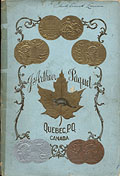 |
|
| |
 J. Arthur
Paquet Catalogue, cover. J. Arthur
Paquet Catalogue, cover.
|
|
| |
|
|
|
The company's second division, launched in 1892 by J. Arthur
Paquet,
one of Zéphirin's sons, was a fur-processing plant. Initially
called
J. Arthur Paquet, its name was changed to La Compagnie Paquet
Limitée,
Division du gros in 1907, and its head office was in the
Pointe-aux-Lièvres
sector of Québec's lower town. This division imported and
exported
raw hides, from which it made articles for women, men, and children,
including
coats, gloves, mittens, and moccasins. It also made snowshoes and felt,
wool,
and straw hats. The company opened branches in Vancouver, Winnipeg,
Toronto,
Montréal, Ottawa, and, later, Saint John, New Brunswick. The
catalogues
of the wholesale division were published in both official languages.
| |
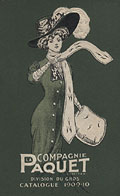 |
|
Cover of the catalogue of
La Compagnie Paquet Limitée, Division du gros, 1909-10.Founded in
1892,
the fur-processing plant called J. Arthur Paquet brought considerable
growth. In June 1907, its name was changed to La Compagnie Paquet
Limitée,
Division du gros. This cover confirms the name change.
|
 |
|
The Pointe-aux-Lièvres processing plant was eventually
converted into
a warehouse. The publication of the catalogue of the wholesale division
most
likely ended at that point; however, the mail-order service and the
publication
of catalogues for the retail division continued. A catalogue published in
the
1960s provides evidence of this.
It is interesting to note Paquet's tendency to target anglophone
customers,
not only through catalogues, but also through ads for the store and the
mail-order
service.
|
Ads for the Mail-order Service
| |
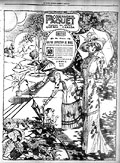 |
|
| |
 Ad
published in Le Soleil, a Québec newspaper, March 19,
1910. Le
Soleil was one of the main newspapers in which La Compagnie Paquet
published ads for its retail division. They were often full-page ads. Ad
published in Le Soleil, a Québec newspaper, March 19,
1910. Le
Soleil was one of the main newspapers in which La Compagnie Paquet
published ads for its retail division. They were often full-page ads.
|
|
| |
|
|
|
According to the "Règlements des Grands Magasins Z. Paquet
de
1907" (policies and procedures of the Z. Paquet department stores
for 1907),
the head of advertising was responsible for the catalogue, as well as
newspaper
ads and flyers and brochures. Two English documents, "Advertising
Account"
and "Advertising Appropriation," clearly indicate the towns
and regions
targeted by the newspaper advertising, for both the store and the
mail-order
service. The ads appeared in both English and French newspapers. In the
early
1910s, promotional ads for the store appeared in five Québec
newspapers.
Ads for the mail-order service were placed in newspapers in various
provinces.
At least one newspaper in each of the following cities carried them:
Arthabaskaville,
Beauceville, Roberval, Sherbrooke, Montréal, and Rectory Hill in
Quebec;
London, Ottawa, Toronto, and Peterborough in Ontario; Glace Bay, Nova
Scotia;
Sussex, New Brunswick; Calgary, Alberta; and Winnipeg, Manitoba (in three
of
the city's newspapers).
|
The Mail-order and Delivery Service
The mail-order service functioned as follows: Correspondence was sent
to the
mail-order office, where it was sorted, read, and filed according to the
department.
"Buyers" (six in all in 1950) went to the departments, bought
the
items, and took them to shipping.
The orders were shipped by mail or train. The railway companies offered
two
types of delivery service: express for light parcels and freight for bulk
orders or very large items. Paquet had its own horses for deliveries in
Québec and the surrounding area. In 1910, there were about 20
horses. Joseph-Arthur Paquet's will, drawn up by a notary in 1907, mentions
that the J. Arthur Paquet company in Montréal had one horse and used a
sleigh in the winter and a buggy in the summer. In 1950, the company had a fleet
of about 20 trucks, which delivered up to 25 000 parcels a month.
The company encouraged its customers to pay
when placing their orders. In the 1911-12 fall-and-winter catalogue, it
informed
its customers that starting on January 1, 1911: "[We will pay] all
transportation
charges for orders of $5 or more shipped by mail, express or freight
…
Anywhere in Canada … to the [railway] station that is closest to
your home
… When the order is shipped COD, we will pay for express service,
but customers
are responsible for the collection fee that the transportation company
will charge.
It is therefore preferable to send us the required amount when placing the
order."
[Transl.]
|
Conclusion — La Compagnie Paquet 100
Years
Later
The Paquet company and its founder became extremely well known. Its
staff,
initially six or seven employees, grew to over 800 a century later.
| |
 |
|
Paquet and its founder were
well known, as this telegram from Prime Minister Wilfrid Laurier attests.
It was sent to Joseph Paquet and the Paquet family when Zéphirin
Paquet
passed away, on February 26, 1905. According to Le Soleil, about
6000 people attended the funeral.
|
 |
|
| |
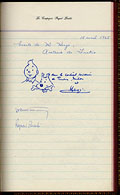 |
|
Hergé, who created
Tintin
and Milou, visited the Rue Saint-Joseph store in 1965. His visit is
confirmed
by his signature and the drawings of the two famous characters from his
comic books, which he left in the gold book kept by La Compagnie Paquet
Limitée.
|
 |
|
| |
 |
|
| |
 The
telephone order department. Paquet had 120 phone lines installed to receive
customers' orders. The
telephone order department. Paquet had 120 phone lines installed to receive
customers' orders.
|
|
| |
|
|
|
Incorporated in 1901, La Compagnie Paquet Limitée occupied 200
000
square feet (1.86 hectares) of sales space on Saint-Joseph Street by 1950.
Its
store had six elevators, an escalator, and 72 departments. Mail order,
catalogues,
and home delivery were always among the services offered. A telephone
order section
was later added. About 7000 orders a day were placed through 120
individual telephone
lines. The contracts section, which handled interior decoration, and the
construction
materials department were among the new services offered by the company.
To meet
the needs of its customers, Paquet also began offering credit and, in
doing so,
abandoned one of the basic principles that were so dear to its founder,
the "no
credit" clause.
Paquet had several warehouses and opened three branches in 1957 in
Chibougamau,
Baie-Comeau, and Sept-Îles. To enhance its competitiveness, it
opened three
others in shopping malls in the 1960s: Place Laurier in Sainte-Foy, Place
Fleur-de-Lys
in Québec, and Les Galeries Chagnon in Lévis. In the
mid-1970s,
it also bought three stores from the Syndicat de Québec, which were
added
to its two department stores in Québec. They were the
company's
last major acquisitions. By the end of that decade, Paquet had about 1500
employees
and annual sales of over $20 million.
As the competition increased, the company was unable to keep up; it
could
not expand at the same rate as American companies while meeting the
union's
demands. In 1981, a strike broke out. La Compagnie Paquet Limitée,
which
was considered Québec's leading trading house was forced to
cease
its activities. It closed its doors in June of that year.
|
Acknowledgements
The author would like to thank Mme Suzanne Paquet Gagnon, Émile
Paquet's
daughter and Zéphirin's granddaughter, who was kind enough to share
her
memories and documentation on Paquet. Our thanks go as well to Jean-Yves
Laurin,
former president of La Compagnie Paquet, who provided useful background on
the
history of the company.
Further Reading
Alcas-Marie, Brother, with a preface by Brother Marie-Victorin, F.
É.
C., Zéphirin Paquet: Sa famille, sa vie, son
œuvre.
Essai de monographie familiale. Québec: n.p., 1927.
Archives nationales du Québec, Québec, Fonds
Paquet-Syndicat
Inc., P 726. Vallières, Marc. "Zéphirin Paquet."
In
Dictionary of Canadian Biography Online, vol. XIII (1901-1910).
(©
2000 University of Toronto/Université Laval. http://www.biographi.ca)
|
| |
|
|